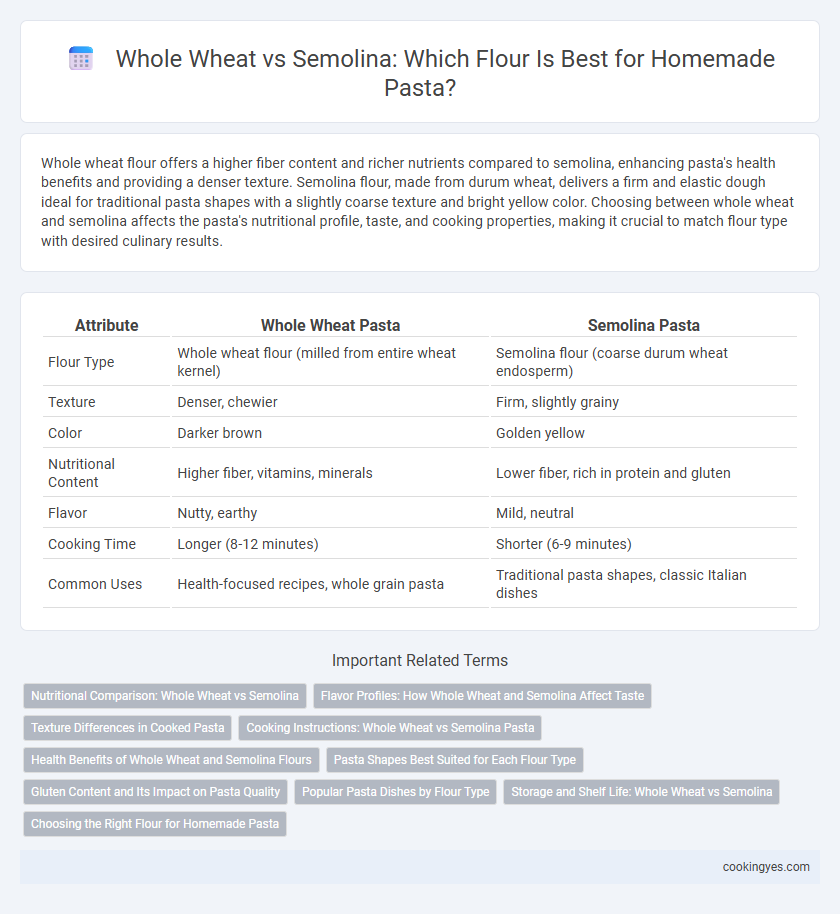Whole wheat flour offers a higher fiber content and richer nutrients compared to semolina, enhancing pasta's health benefits and providing a denser texture. Semolina flour, made from durum wheat, delivers a firm and elastic dough ideal for traditional pasta shapes with a slightly coarse texture and bright yellow color. Choosing between whole wheat and semolina affects the pasta's nutritional profile, taste, and cooking properties, making it crucial to match flour type with desired culinary results.
Table of Comparison
| Attribute | Whole Wheat Pasta | Semolina Pasta |
|---|---|---|
| Flour Type | Whole wheat flour (milled from entire wheat kernel) | Semolina flour (coarse durum wheat endosperm) |
| Texture | Denser, chewier | Firm, slightly grainy |
| Color | Darker brown | Golden yellow |
| Nutritional Content | Higher fiber, vitamins, minerals | Lower fiber, rich in protein and gluten |
| Flavor | Nutty, earthy | Mild, neutral |
| Cooking Time | Longer (8-12 minutes) | Shorter (6-9 minutes) |
| Common Uses | Health-focused recipes, whole grain pasta | Traditional pasta shapes, classic Italian dishes |
Nutritional Comparison: Whole Wheat vs Semolina
Whole wheat pasta flour contains higher dietary fiber, vitamins B and E, and essential minerals like magnesium and zinc compared to semolina, which primarily offers a finer texture and higher protein content suitable for pasta elasticity. Semolina flour, made from durum wheat, provides more gluten strength, resulting in firmer pasta but lacks the bran and germ, reducing its fiber and micronutrient density. Choosing whole wheat pasta supports better digestive health and sustained energy release due to its complex carbohydrates and richer nutrient profile.
Flavor Profiles: How Whole Wheat and Semolina Affect Taste
Whole wheat pasta flour imparts a nutty, earthy flavor with a slightly robust and hearty taste, enhancing depth and complexity. Semolina flour, derived from durum wheat, offers a mild, slightly sweet, and more neutral flavor that allows sauces to stand out. The choice between whole wheat and semolina directly influences pasta's taste intensity and pairing versatility.
Texture Differences in Cooked Pasta
Whole wheat pasta typically has a denser, chewier texture due to the presence of bran and germ, creating a heartier bite compared to semolina pasta. Semolina flour, derived from durum wheat, produces pasta with a firm, slightly grainy texture that retains a desirable al dente quality when cooked. The coarse, granular nature of semolina contributes to a smoother surface and a more elastic consistency, enhancing the overall mouthfeel of traditional pasta dishes.
Cooking Instructions: Whole Wheat vs Semolina Pasta
Cooking whole wheat pasta requires slightly more water and a longer boiling time, typically 9 to 12 minutes, to achieve a tender texture without overcooking. Semolina pasta cooks faster, usually in 7 to 9 minutes, as the finer texture absorbs water more quickly and maintains a firm al dente bite. Stirring whole wheat pasta occasionally during cooking prevents clumping, while semolina pasta benefits from a rapid boil to ensure even cooking and optimal texture.
Health Benefits of Whole Wheat and Semolina Flours
Whole wheat flour contains more fiber, vitamins, and minerals, supporting digestion and heart health compared to semolina flour, which is primarily refined and lower in nutrients. Semolina provides a higher protein content and essential gluten strength, making it ideal for pasta texture and cooking quality. Choosing whole wheat pasta promotes better blood sugar control and increased satiety due to its complex carbohydrate profile.
Pasta Shapes Best Suited for Each Flour Type
Whole wheat flour produces denser pasta shapes like fusilli and rigatoni, which hold sauces well due to their rough texture. Semolina flour, with its high gluten content and firm consistency, is ideal for traditional shapes such as spaghetti and penne that require a firmer bite. Choosing the right flour enhances the pasta's texture and overall cooking performance based on the shape's surface area and thickness.
Gluten Content and Its Impact on Pasta Quality
Whole wheat flour contains higher fiber and protein but has variable gluten quality, which can affect pasta's elasticity and firmness. Semolina flour, derived from durum wheat, boasts a higher, more robust gluten content, contributing to pasta's ideal texture and bite. The gluten structure in semolina facilitates better dough strength, resulting in pasta that holds shape well during cooking and delivers a superior al dente quality.
Popular Pasta Dishes by Flour Type
Whole wheat pasta flour offers a nutty flavor and higher fiber content, making it ideal for hearty dishes like whole wheat spaghetti with roasted vegetables or whole wheat penne arrabbiata. Semolina flour provides a coarse texture and firm bite, preferred in classic Italian recipes such as traditional semolina-based gnocchi and tagliatelle alla Bolognese. Choosing between whole wheat and semolina pasta flours influences the nutritional profile and texture of popular pasta dishes, catering to different taste preferences and dietary needs.
Storage and Shelf Life: Whole Wheat vs Semolina
Whole wheat flour contains higher oil content from the wheat germ, leading to a shorter shelf life of about 1 to 3 months when stored in a cool, dry place, while semolina flour, being more refined and lower in oils, typically lasts 6 to 8 months under similar conditions. Proper airtight storage and refrigeration can extend whole wheat flour's freshness and prevent rancidity. Semolina's longer shelf life makes it more convenient for bulk storage and prolonged pasta production timelines.
Choosing the Right Flour for Homemade Pasta
Whole wheat flour offers higher fiber content and a nuttier flavor, making it a nutritious choice for homemade pasta, while semolina flour provides a coarser texture and higher protein level, resulting in a firm, al dente bite. Semolina's gluten strength creates pasta that holds shape well during boiling, ideal for traditional Italian dishes, whereas whole wheat pasta tends to be denser and may require careful hydration adjustments. Selecting the right flour depends on the desired texture, nutritional profile, and cooking method to achieve perfect, homemade pasta.
Whole wheat vs semolina for pasta flour Infographic

 cookingyes.com
cookingyes.com